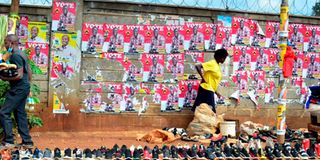Poll promises with no clear road map are just hot air

A resident of Karuri ward in Kiambaa Constituency walks past a wall full of campaign posters on July 14, 2021.
What you need to know:
- Some aspirants for elective offices are making many promises to build roads and to improve health facilities.
- Others promise to increase bursaries and ensure their people get more resources.
Politics without policy is empty. And policy without politics is blind, so says Ian Shapiro, a political science professor at Yale. And it is easy to see why.
Aspirants for elective offices are making many promises. To improve service delivery (what does that mean?), to build roads, to improve health facilities, to ensure that the facilities have all the medicines and so on.
Others promise to increase bursaries and ensure their people get more resources (no one says from where). Yet others promise farm inputs, better pay for ECDE teachers, salaries for community health volunteers, improved security, jobs and so on.
But without a clear plan of how to achieve these things, it is all hot air. Political rhetoric. Take the pledge to pay ECDE teachers better. It would be great to be able to do so, but most counties’ salaries and wages already exceed the mandatory limit of 35 per cent of their budgets. This pledge must therefore be backed by a clear method of raising more own-source revenue.
To ensure all health facilities have sufficient medicines, you first need high quality data on morbidity by area, as disease incidence varies from one area to the next. The medicines you need also vary accordingly. And it is not only expensive but impractical to stock every possible medicine in all facilities because some require temperature-controlled storage and so on.
Supply-chain hiccups
Second, you have to solve supply-chain hiccups. The main supplier of medicines by law is the Kenya Medical Supplies Authority (Kemsa). Their fill rate, however, rarely exceeds 70 per cent. That means you need other strong suppliers to fill the gap.
Creating jobs
But perhaps the biggest barrier is the ability of clients to pay. Even in areas with high health insurance penetration such as Laikipia, up to 35 per cent of citizens are still not covered by NHIF or any other insurance.
Finally, bulk buying by Kemsa (the reason they were given a monopoly) has not brought down prices. We are paying two to four times more for medicines and commodities compared to India!
In Laikipia, we are experimenting with technology and a networked pharmacy across our 87 Laikipia Health Service outlets. This gives the dispensing pharmacist a full view of the medicines available in the network. If it is not in her outlet, she can ask for it from elsewhere in the network.
Unemployment is another big issue. When somebody promises jobs, we listen. But pray do they have even the faintest clue as to how they will fulfil their pledge?
One idea is that we should use ICT to create jobs. Indeed, it was on this premise the National Optic Fibre Backbone (NOFBI) was built. By June 2016 (yes, six years ago in 2016), more than 6,000km of it had been laid in the 47 counties! However, most young leaders have never heard of NOFBI, which was intended to bridge the digital divide and to spur ICT products and services.
It is not enough to build the hardware. Critical work remains on the software side. How do people use the hardware for the intended impact, including creating jobs? As you make your choices, kindly ponder!
@NdirituMuriithi is the Governor of Laikipia County.





